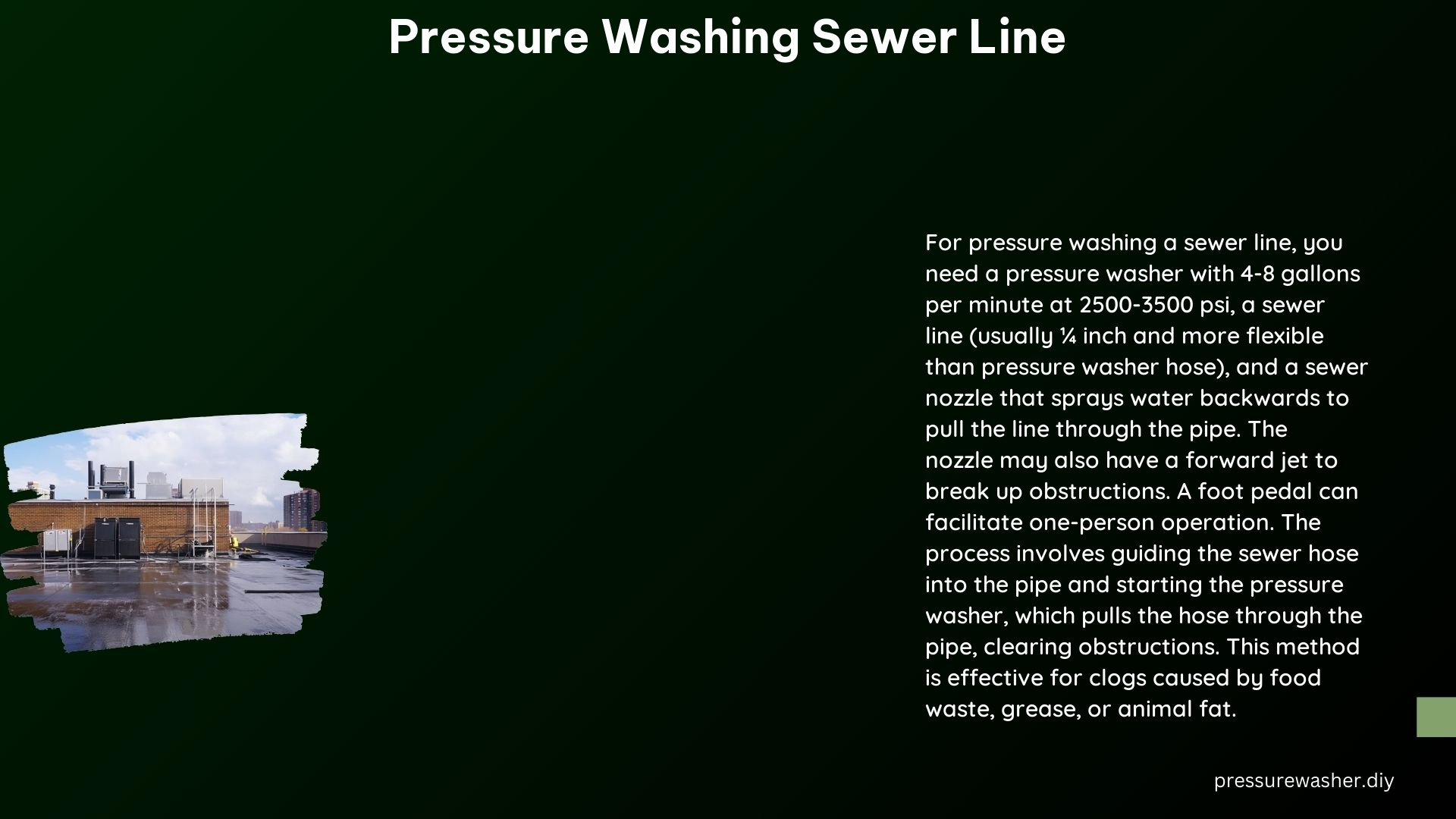Pressure washing a sewer line is a highly effective method for clearing blockages, removing debris, and maintaining the integrity of your home’s plumbing system. This comprehensive guide delves into the technical specifications, recommended equipment, and best practices for pressure washing sewer lines, ensuring a successful and efficient cleaning process.
Recommended Flow Rate and Pressure
The optimal flow rate for pressure washing a sewer line typically ranges between 4-8 gallons per minute (GPM) at a pressure of 2500-3500 pounds per square inch (PSI). This combination of flow rate and pressure is highly effective in breaking up and flushing out obstructions, such as grease buildup, tree roots, and accumulated sediment, from the sewer pipes.
It’s important to note that using a flow rate or pressure outside of this recommended range can lead to suboptimal cleaning results or even potential damage to the sewer line. Carefully selecting a pressure washer or sewer jetter that meets these specifications is crucial for achieving the desired cleaning outcome.
Using a Rented Pressure Washer

Renting a pressure washer can be a cost-effective option for pressure washing a sewer line, but it’s essential to ensure that the rented equipment meets the recommended flow rate and pressure requirements. Before starting the cleaning process, thoroughly inspect the pressure washer and confirm that it can deliver the necessary 4-8 GPM at 2500-3500 PSI.
Additionally, ensure that the pressure washer is compatible with the sewer jetter kit and nozzles you plan to use. Some pressure washers may have unique connections or features that may not be compatible with the sewer cleaning equipment, so it’s crucial to verify the compatibility before renting the pressure washer.
Choosing the Right Nozzle
The type of nozzle used for pressure washing a sewer line can significantly impact the effectiveness of the cleaning process. Consider the following factors when selecting the appropriate nozzle:
-
Nozzle Type: There are several nozzle types available, each designed for specific tasks. Button nose nozzles are effective for breaking up obstructions, while corner nozzles can reach tight spaces, and rotating nozzles provide a more thorough flushing action.
-
Orifice Size: The orifice size of the nozzle determines the pressure and flow rate of the water stream. A larger orifice size will result in a higher flow rate but lower pressure, while a smaller orifice size will produce a lower flow rate but higher pressure. Choose the orifice size that best suits the specific cleaning requirements of your sewer line.
-
Material: Nozzles can be made from various materials, such as stainless steel or brass. Opt for a nozzle constructed from a durable material that can withstand the high pressure and flow rate during the cleaning process.
Technical Specifications
When pressure washing a sewer line, it’s essential to consider the following technical specifications to ensure the safety and effectiveness of the cleaning operation:
-
Hose Length and Diameter: A longer hose (e.g., 100 feet) with a smaller diameter (e.g., 1/4 inch) is often preferred for sewer line cleaning, as it provides more flexibility and easier maneuverability within the pipes.
-
Working Pressure and Burst Pressure: The hose used for sewer line cleaning should have a working pressure of at least 5800 PSI, with a burst pressure of up to 11000 PSI. This ensures that the hose can withstand the high pressure required for effective cleaning without the risk of rupture.
-
Connection Type: Ensure that the hose and nozzle connections are compatible with your pressure washer and other equipment. Common connection types include M22 and 1/4 inch NPT.
Additional Tips for Pressure Washing Sewer Lines
To further enhance the effectiveness and safety of your sewer line pressure washing, consider the following additional tips:
- Use a foot pedal or trigger gun to control the pressure washer, allowing for easier operation and hands-free guidance of the hose.
- Mount the sewer line on a cart or reel for easier access to cleanouts and to prevent entanglement of the hose.
- Invest in high-quality, heavy-duty hoses and nozzles designed specifically for sewer line cleaning to ensure durability and long-term performance.
By following these technical guidelines and best practices, you can effectively pressure wash your sewer line, clearing blockages, removing debris, and maintaining the overall health of your home’s plumbing system.
References
- Amazing Machinery. (n.d.). Pressure Washer to Sewer Jetter Conversion Kits. Retrieved from https://www.amazingmachinery.com/pressure-washer-to-jetter-conversion.html
- Amazon. (n.d.). Sewer Jetter Kit 100FT for Pressure Washer, 5800PSI Drain Cleaner. Retrieved from https://www.amazon.com/Pressure-5800PSI-Cleaner-Rotating-Waterproof/dp/B085WJ4GWG
- Forbes. (2024, April 14). How Much Does It Cost To Hydro Jet A Sewer Line? Retrieved from https://www.forbes.com/home-improvement/plumbing/hydrojet-sewer-line-cost/
- Pressure Washers Direct. (n.d.). How to Clear Sewer and Drain Pipes. Retrieved from https://www.pressurewashersdirect.com/stories/905-How-to-Clear-Sewer-and-Drain-Pipes.html
- YouTube. (2019, October 8). How to Clean Sewer Pipes with a Pressure Washer. Retrieved from https://www.youtube.com/watch?v=Rt5Uo_2PLnM
